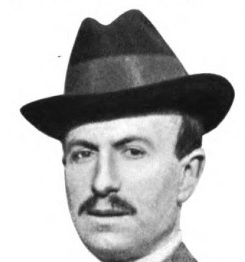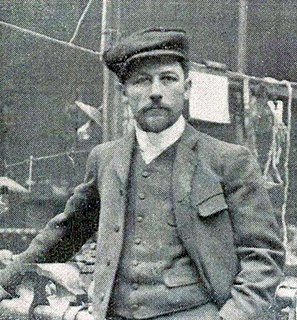
Vabis was the abbreviation and later also trademark of Swedish railway car manufacturer Vagnfabriks Aktiebolaget iSödertälje, which translates Wagon Factory Limited Company of Södertälje, established in 1891 in Södertälje. Vabis also manufactured petrol engines, automobiles, trucks, motor-powered draisines, motorboats and marine engines. The company was in 1911 merged with Maskinfabriks-aktiebolaget Scania, to form Scania-Vabis.

Sir Harry Ralph Ricardo was an English engineer who was one of the foremost engine designers and researchers in the early years of the development of the internal combustion engine.

David Brown Engineering Limited is an English engineering company, principally engaged in the manufacture of gears and gearboxes. Their major gear manufacturing plant is in Swan Lane, Lockwood, Huddersfield, adjacent to Lockwood railway station. It is named after the company's founder, David Brown, though it is more closely associated with his grandson, Sir David Brown (1904–1993).
Clément-Bayard, Bayard-Clément, was a French manufacturer of automobiles, aeroplanes and airships founded in 1903 by entrepreneur Gustave Adolphe Clément. Clément obtained consent from the Conseil d'Etat to change his name to that of his business in 1909. The extra name celebrated the Chevalier Pierre Terrail, seigneur de Bayard who saved the town of Mézières in 1521. A statue of the Chevalier stood in front of Clément's Mézières factory, and the image was incorporated into the company logo.

L'Aster, Aster, Ateliers de Construction Mecanique l'Aster, was a French manufacturer of automobiles and the leading supplier of engines to other manufacturers from the late 1890s until circa 1910/12. Although primarily known as an engine mass manufacturer the company also produced chassis for coach-works and a complete range of components.

Albion Motors was a Scottish automobile and commercial vehicle manufacturer.

Phelon & Moore manufactured motorcycles in Cleckheaton, Yorkshire, England from 1904 to 1967 particularly those under the Panther marque. They became identified with one particular design of motorcycle which had a large sloping 40-degree single-cylinder engine as a stressed member of the frame. This design spanned the entire history of the company, starting with a 500 cc model and ending with a 645 cc model.

The Valveless was an English automobile manufactured, after lengthy development, from 1908 until 1915 in Huddersfield, Yorkshire. The successor to the Ralph Lucas Valveless, the car marked the entry of the David Brown & Sons group into the manufacture of motors. Its engine was a 20 or 25 hp duplex two-stroke model which was advertised as having "only six working parts"; these included two pistons, two connecting rods, and two crankshafts, which were geared together and counter-rotated. This is a type of engine configuration known as a split single since it is effectively a single cylinder split into two.

Diatto was an Italian manufacturing company founded in 1835 in Turin by Guglielmo Diatto to make 'carriages for wealthy customers'. In 1874 Guglielmo’s sons, Giovanni and Battista Diatto, began building railway carriages for Compagnie Internationale des Wagons-Lits and the Orient Express. In 1905 Guglielmo's grandsons, Vittorio and Pietro Diatto, began Diatto-Clément, a cooperative venture making motor-vehicles under license from French manufacturer Clément-Bayard owned by industrialist Adolphe Clément-Bayard. By 1909 they had full ownership of 'Autocostruzioni Diatto' and began developing their own motor-vehicles and exporting them worldwide.
The LuLu cyclecar was produced by the Kearns Motor Car Company. The company was founded by Charles Maxwell Kearns I in Beavertown, Snyder County, Pennsylvania about 1903. Kearns was the son of a buggy maker and had a gift for invention but little more than a grade school education. He began by first mounting an engine on a buggy and progressed to more elaborate designs and heavy trucks. The LuLu automobile was manufactured only in 1914. Billed as "more than a cyclecar", it had a four-cylinder monobloc engine and three-speed gearing. It sold for $398.

Frederick Richard Simms was a British mechanical engineer, businessman, prolific inventor and motor industry pioneer. Simms coined the words "petrol" and "motorcar". He founded the Royal Automobile Club, and the Society of Motor Manufacturers and Traders.

The Union automobile was a vehicle that came about from John William Lambert. He developed in 1895 a four-wheel gasoline engine powered horseless carriage from a three-wheel buggy version he had previously made in 1891. He developed a gasoline engine powerful enough to propel a wagon with passengers. He also invented a friction drive gearless transmission for such a vehicle. He then formed a company of men to manufacture his automobile at Union City, Indiana. His automobile was manufactured by the Union Automobile Company from 1902 into 1905. There were over three hundred Union automobiles made and sold all total. The demise of the automobile came about through development into another vehicle called a Lambert.

The Lambert Automobile Company developed as a 300,000-square-foot (28,000 m2) automobile factory in Anderson, Indiana. It manufactured the Lambert automobile, truck, fire engine and farm tractor through the governing Buckeye Manufacturing Company. Production of vehicles manufactured by the company had been from 1905-1915. In 1910 the company had over a thousand employees and from 1910 to 1915 the production had reached about three thousand vehicles per year. It went out of business in 1917 because of World War I.

Léon Serpollet was a French engineer and developer of flash steam boilers and steam automobiles.

The Maudslay Motor Company was a British vehicle maker based in Coventry. It was founded in 1902 and continued until 1948 when it was taken over by the Associated Equipment Company (AEC) and along with Crossley Motors the new group was renamed Associated Commercial Vehicles (ACV) Ltd.

The Buckeye gasoline buggy, also known as the Lambert gasoline buggy, was an 1891 gasoline automobile, the first made in the United States. It was also the first automobile made available for sale in the United States. It was initially a three wheel horseless carriage, propelled by an internal combustion gasoline engine; it was later developed into a four-wheel automobile with a gearless transmission, and mass-produced during the first part of the twentieth century. The platform was later expanded into a line of trucks and fire engines.

The Union Automobile Company was an automobile factory to manufacture the Union automobile through the Buckeye Manufacturing Company. It began manufacturing automobiles in 1902 and produced them through 1905. The company was located in Union City, Indiana. The inventor of Union automobile gasoline engine and friction drive gearless transmission was John W. Lambert. In the early part of 1905 the company moved to Anderson, Indiana. It had produced 325 automobiles before going out of business in the later part of 1905. It was replaced with a redesigned model that became the Lambert automobile.

Gustave Adolphe Clément, from 1909 Clément-Bayard, was a French entrepreneur. An orphan who became a blacksmith and a Compagnon du Tour de France, he went on to race and manufacture bicycles, pneumatic tyres, motorcycles, automobiles, aeroplanes and airships.
Mary Lucas, sometimes referred to as Mary Anderson Lucas, was an English composer and pianist.
Frederick Ridley Dennison (1876–1960) was an Oamaru mechanical engineer who designed and built New Zealand's first indigenous motor car in 1900 and first bus in 1906.
















